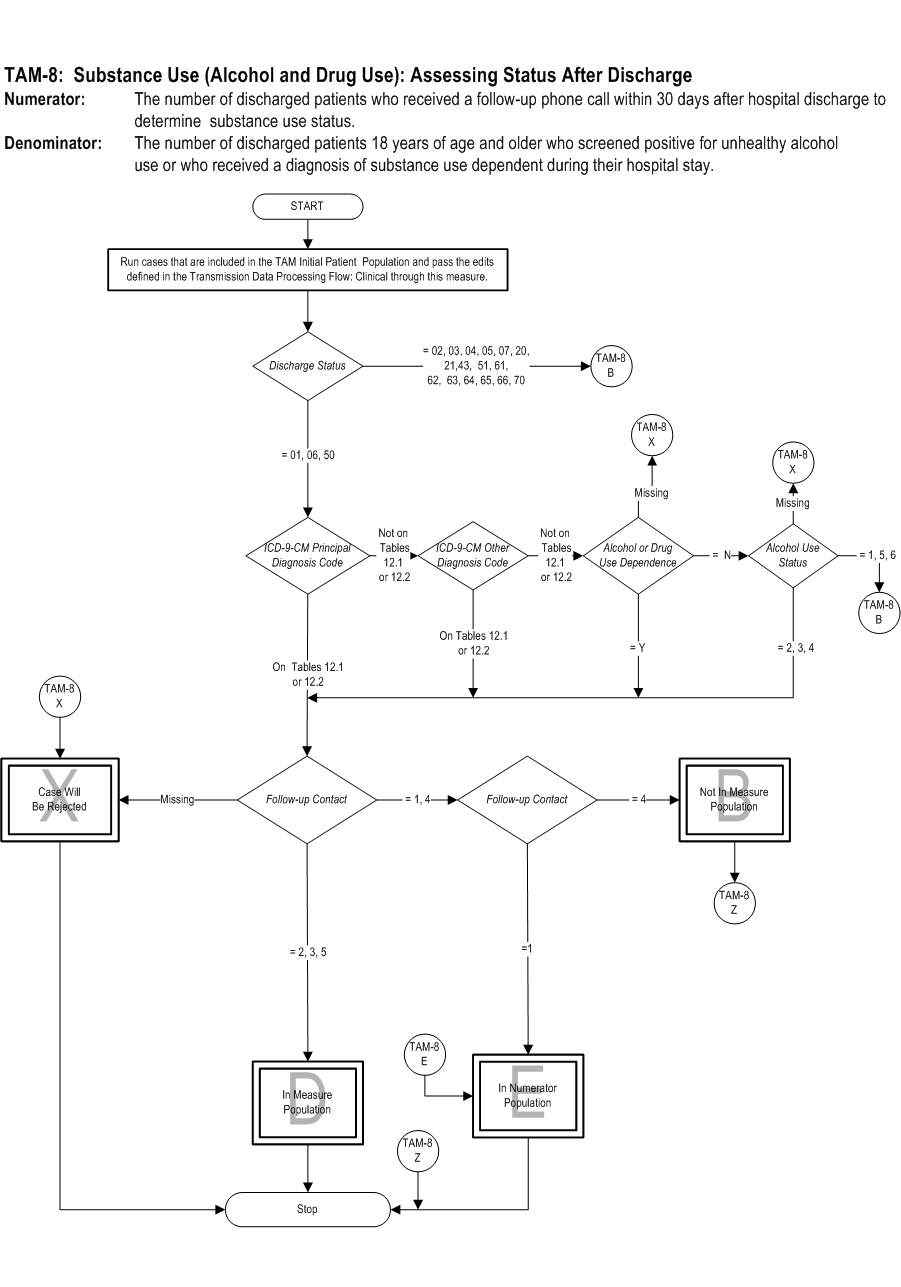|
|
Release Notes:
Measure Information Form Version 2010B Measure Information Form Numerator Statement: The number of discharged patients who received a follow-up contact within 30 days after hospital discharge to determine substance use status
Risk Adjustment: No.
Data Collection Approach: Retrospective data sources for required data elements include administrative data and medical records. Some hospitals may prefer to gather data concurrently by identifying patients in the population of interest. This approach provides opportunities for improvement at the point of care/service. However, complete documentation includes the principal and other ICD-9-CM diagnoses which require retrospective data entry.
Data Accuracy: Data accuracy is enhanced when all definitions are used without modification. The data dictionary should be referenced for definitions and abstraction notes when questions arise during data collection.
Measure Analysis Suggestions: Hospitals may wish to analyze the measure data using the test data element Substance Use Status Post Discharge to determine the difference in use status related to interventions made during the hospital stay or referrals at discharge.
Sampling: Yes. For additional information see the Population and Sampling Specifications section
Data Reported As: Aggregate rate generated from count data reported as a proportion.
Selected References:
1. The National Quality Forum, National Voluntary Consensus Standards for the Treatment of Substance Use Conditions: Evidence-Based Treatment Practices; A Consensus Report; 2007.
2. Harwood, HJ, 2000. Updating Estimates of the Economic Costs of Alcohol Abuse in the United States. National Institute on Alcohol Abuse and Alcoholism. Available from: http://pubs.niaaa.nih.gov/publications/economic-2000,
3. Office of National Drug Control Policy. The Economic Costs of Drug Abuse in the United States: 19922002. Washington, DC: Executive Office of the President (Publication No. 207303), 2004.
4. Mokdad AH, Marks JS, Stroup DS, Gerberding JL. Actual Causes of Death in the United States, 2000. JAMA. 2004 Mar 10;291(10):1238-45 (Erratum in: JAMA. 2005 Jan 19;293(3):293-4.)
5. Madras BK, Compton WM, Avula D, Stegbauer T, Stein JB, Clark HW. Screening, brief interventions, referral to treatment (SBIRT) for illicit drug and alcohol use at multiple healthcare sites: Comparison at intake and 6 months later. Drug Alcohol Depend. 2009 Jan 1;99(1-3):280-95. Epub 2008 Oct 16.
6. Fleming MF, Mundt MP, French MT, Manwell LB, Stauffacher EA, Barry KL. Brief physician advice for problem drinkers: Long-term efficacy and cost-benefit analysis. Alcohol Clin Exp Res. 2002 Jan;26(1):36-43.
7. Gentilello LM, Ebel BE, Wickizer TM, Salkever DS Rivera FP. Alcohol interventions for trauma patients treated in emergency departments and hospitals: A cost benefit analysis. Ann Surg. 2005 Apr;241(4):541-50.
8. Gentilello LM, Villaveces A, Ries RR, Nason KS, Daranciang E, Donovan DM Copass M, Jurkovich GJ Rivara FP. Detection of acute alcohol intoxication and chronic alcohol dependence by trauma center staff. J Trauma. 1999 Dec;47(6):1131-5; discussion 1135-9.
9. Bernstein J, Bernstein E, Tassiopoulos K, Heren T, Levenson S, Hingson R. Brief motivational interventions at a clinic visit reduces cocaine and heroin use. Drug Alcohol Depend. 2005 Jan 7;77(1):49-59.
10. McGlynn EA, Asch SM, Adams J. The Quality of Healthcare Delivered to Adults in the United States. N Engl J Med. 2003 Jun 26;348(26):2635-45.
11. Smothers BA, Yahr HT, Ruhl CE. Detection of alcohol use disorders in general hospital admissions in the United States. Arch Intern Med. 2004 Apr 12;164(7):749-56.
12. Kirchner JE, Owen RR, Nordquist C, Fischer EP. Diagnosis and management of substance use disorders among inpatients with schizophrenia. Psychiatr Serv. 1998 Jan;49(1):82-5.
13. Havassy BE, Alvidrez J, Owen KK. Comparisons of patients with comorbid psychiatric and substance use disorders: implications for treatment and service delivery. Am J Psychiatry. 2004 Jan;161(1):139-45.
14. Prochaska JJ, Gill PH, Stephen E, Hall SM. Identification and Treatment of Substance Misuse on an Inpatient Psychiatry Unit. Psychiatr Serv. 2005 Mar;56(3):347-9.
15. Kirchner JE, Owen RR, Nordquist C, Fischer EP. Diagnosis and management of substance use disorders among inpatients with schizophrenia. Psychiatr Serv. 1998 Jan;49(1):82-5.
16. Havassy BE, Alvidrez J, Owen KK. Comparisons of patients with comorbid psychiatric and substance use disorders: implications for treatment and service delivery. Am J Psychiatry. 2004 Jan;161(1):139-45.
17. Prochaska JJ, Gill PH, Stephen E, Hall SM. Identification and Treatment of Substance Misuse on an Inpatient Psychiatry Unit. Psychiatr Serv. 2005 Mar;56(3):347-9.
Measure Algorithm:
Included Populations: Not applicable Excluded Populations:Denominator Statement: The number of discharge patients 18 years of age and older who screened positive for unhealthy alcohol use or who received a diagnosis of alcohol or drug dependence during their hospital stay. Included Populations: 
 Attach file Attach file
|
|||
Questions? Ask Question to Joint Commission staff
Copyright © 2010 by The Joint Commission.